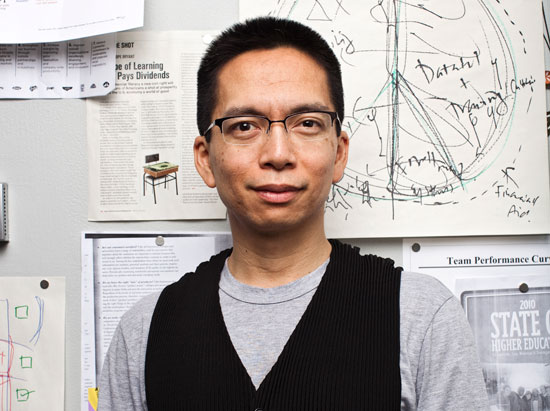John Maeda is a world-renowned artist and graphic designer; he's also a computer scientist and an electrical engineer. He's a recipient of the National Design Award and has work in the permanent collection of the Museum of Modern Art.
He's also president of the most prestigious art and design school in the world: The Rhode Island School of Design.
I met John in the lobby of his hotel a few hours before his scheduled appearance at the Seattle RISD Alumni Club meeting. Here is an abbreviated version of our hour-long conversation.
Darby Roach: Hi John, sorry it has to be such a rainy Seattle day for your visit.
John Maeda: That's okay, you know I'm from Seattle so I'm used to it.
DR: You've done some groundbreaking art and design. Are you still making art?

John Maeda, President, Rhode Island School of Design
JM: People ask me that and I say, yeah; it's a big installation called RISD. We're exploring how art and design fit into the national landscape.
DR: That's quite a task. It seems that art and design aren't appreciated as much as they once were. How do we get people to value what we artists and designers do?
JM: I was speaking on a panel with Eric Schmidt, former CEO and executive chairman of Google, and someone asked him, 'Google can make anything happen these days, but what's the future look like?' And within nanoseconds, Eric said, 'Well, it's about quality.'
Anyone with a computer and a design program can create a page layout. But unless you're trained in design, it won't look very good and it won't communicate very well. On the other hand, people will beat down the door for quality. They can see it, they can taste it but you have to put it within reach.
DR: How do we do that?
JM: Museums are important. Design and art schools are important because they show how it should be done at the highest level of quality. Once people are exposed to quality, they recognize it right away and they appreciate it. People's tastes are changed by exposure to quality. Unless they can see it they can't want it. That's the brilliance of Apple - (computer) they provide quality in design.
DR: Speaking of computers, it seems to be all about technology these days and design and art take a back seat. In the days of Leonardo, there wasn't that distinction between technology, science and art. What's happening at RISD to bring things back into whack?
JM: In the 70's and 80's there was an attempt in K-12 to teach science through art or art through science. The challenge today is how do you build the ethos of art and design into the academy of science.
DR: How do you accomplish that at RISD?
JM: Oh, well, one thing we're doing is that we're bringing in different partners. So we had the National Science Foundation come to campus for a workshop. We brought together scientists, educators and artists. We also had the Robert Wood Johnson Foundation join us for Make It Better: A Conversation on Art, Design and the Future of Healthcare. It was valuable to bring in the (scientific) expertise to bond with the artist's expertise and imagine possible collaborations.
RISD represents creative people. We're innovators. We're unafraid to fail. And in this economy people keep asking for the kind of talent that can make things. One of the challenges to our nation today is overcoming the notion that art is kind of a nice-to-have, when in reality art is a need-to-have.
That realization doesn't happen often especially when you come from technology, when you come from established STEM subjects. Extending STEM to STEAM by adding Art makes sense, because STEM by itself is extremely powerful. Its scale is amazing. But that alone doesn't create warmth and humanity and connection. For instance, a thing like an MP3 Player is a STEM technology. But until Apple came along, it didn't become desirable. It was a STEAM technology that made it a part of our everyday lives.
(STEM is an acronym for science, technology, engineering and mathematics. It's the field of studies the government believes deserves the greatest emphasis in education.)
DR: You do a lot of work creating connections between artists and designers and those in the fields of science and technology. Do you see a time when the arts regain a position of greater importance in education and the economy?
JM: It's happening right now and RISD is a big part of that. Because of my position at RISD, I'm privileged to see a view of the world that most people don't get to see, which is that there are so many creative people in the world and they're all positioned differently. My goal is to see how RISD can serve the purpose of being a kind of magnet for all of this interesting talent. So that we're not thinking so much of something as being art or design or science or engineering, but seeing it for what it is...to move across fields to find these natural connections.
The question then becomes, how do you empower that massive network of curiosity and make others understand that important discoveries don't just come from the sciences but that they come from art and design, too.
I believe the work being done by our students at RISD is the best proof of that.

